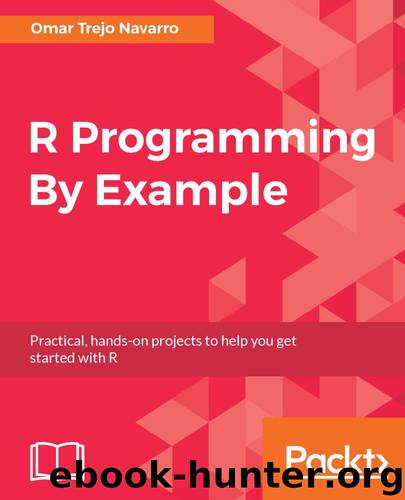R Programming By Example: Practical, hands-on projects to help you get started with R by Omar Trejo Navarro

Author:Omar Trejo Navarro [Navarro, Omar Trejo]
Language: eng
Format: epub
Tags: COM042000 - COMPUTERS / Natural Language Processing, COM077000 - COMPUTERS / Mathematical and Statistical Software, COM051010 - COMPUTERS / Programming Languages / General
Publisher: Packt Publishing
Published: 2017-12-22T00:00:00+00:00
Extending our analysis with cosine similarity
Now we proceed to another technique familiar in linear algebra which operates on a vector space. The technique is known as cosine similarity (CS), and its purpose is to find vectors that are similar (or different) from each other. The idea is to measure the direction similarity (not magnitude) among client messages, and try to use it to predict similar outcomes when it comes to multiple purchases. The cosine similarity will be between 0 and 1 when the vectors are orthogonal and perpendicular, respectively. However, this similarity should not be interpreted as percentage because the movement rate for the cosine function is not linear. This means that a movement from 0.2 to 0.3 does not represent a similar movement magnitude from 0.8 to 0.9.
Given two vectors (rows in our DFM), the cosine similarity among them is computed by taking the dot product between them and dividing it by the product of the Euclidian norms. To review what these concepts mean, take a look at Meyer's, Matrix Analysis & Applied Linear Algebra, 2000.
Download
This site does not store any files on its server. We only index and link to content provided by other sites. Please contact the content providers to delete copyright contents if any and email us, we'll remove relevant links or contents immediately.
Sass and Compass in Action by Wynn Netherland Nathan Weizenbaum Chris Eppstein Brandon Mathis(7967)
Supercharging Productivity with Trello by Brittany Joiner(7324)
Mastering Tableau 2023 - Fourth Edition by Marleen Meier(7091)
Inkscape by Example by István Szép(6963)
Secrets of the JavaScript Ninja by John Resig Bear Bibeault(6736)
Visualize Complex Processes with Microsoft Visio by David J Parker & Šenaj Lelić(6644)
Build Stunning Real-time VFX with Unreal Engine 5 by Hrishikesh Andurlekar(5672)
Design Made Easy with Inkscape by Christopher Rogers(4995)
Customizing Microsoft Teams by Gopi Kondameda(4537)
Business Intelligence Career Master Plan by Eduardo Chavez & Danny Moncada(4435)
Extending Microsoft Power Apps with Power Apps Component Framework by Danish Naglekar(4149)
Salesforce Platform Enterprise Architecture - Fourth Edition by Andrew Fawcett(4012)
Linux Device Driver Development Cookbook by Rodolfo Giometti(4008)
Pandas Cookbook by Theodore Petrou(4001)
The Tableau Workshop by Sumit Gupta Sylvester Pinto Shweta Sankhe-Savale JC Gillet and Kenneth Michael Cherven(3815)
Exploring Microsoft Excel's Hidden Treasures by David Ringstrom(3289)
TCP IP by Todd Lammle(3117)
Applied Predictive Modeling by Max Kuhn & Kjell Johnson(3006)
Drawing Shortcuts: Developing Quick Drawing Skills Using Today's Technology by Leggitt Jim(2975)
